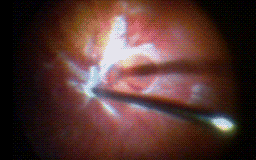FREQUENTLY ASKED QUESTIONS
Refractive surgery with excimer Laser
How long has this method of excimer laser surgery operating been used ?
The first operations date back to 1985 but in Italy the first lasers arrived in 1988. Actually the second laser in Italy was installed back in 1988 in Ravenna, using the same specialist team that today works in Cidiemme.
Can people suffering from short and long-sightedness and hypermetropia with astigmatic defects be operated ?
Today it is possible to operate surgically on any refractive defect, therefore both far and near-sightedness , hypermetropia associated or not with astigmatism, as well as astigmatic defects. The latest generation of laser is ideal for astigmatism and today’s results are significantly better than on old generation lasers and the results are often surprisingly good.
What are the limits in terms of vision gradation that the laser therapy can handle?
There is no absolute universal rule, because this depends on the anatomy of the individual patient. The corneal morphology and topography as well as its thickness and the pupil diameter are all factors that need to be evaluated. On average the new laser method can handle 12 dioptres of myopia and 6-7 of hypermetropia. Astigmatism is a different specific story. The minimum levels of correction are very low (0,50-0,75) and depends on the patient’s real need to correct their vision.
Is the operation final?
Once the scarring period has passed (approx. 6 months, maximum 1 year) the cornea can be said to be stable, and consequently the resulting refractive condition. In time all eye structures, as all other tissues and organs, change as we get older and accordingly, based on the rate of change, additional refractive deficiencies can appear normally around the 50-55 year age mark.
How long does the surgery last?
The process is very quick, the laser treatment itself lasts from a few seconds to a couple of minutes depending on the defect that is being treated. Prior to the intervention the preparation lasts 2-4 minutes.
Is the intervention painful?
No, the operation is not painful, only a tactile sensation and a light burning, to this end anaesthetic collirio is used.
What happens if I move the eye during the operation?
The new generation of lasers have a pointing function that is derived from missile systems and that follows the eye movements even when they are very small. Large movements will automatically interrupt the beam. Today the “eye tracker” in the modern lasers allow even rotary and longitudinal eye movements to be compensated with an extremely frequent and fast reaction time. Logically the ideal operation, the one that has the best chance of success at the lowest risk, is the one that is done quickly and cleanly reducing the need to compensate as much as possible, this requires a careful collaboration on the part of the patient.
Is the postoperative period very complicated?
After a surface intervention (prk or lasek) there are a couple of days of nuisance with the chance of feeling pain and tears. The next 4-5- days of convalescence are required where attention to hygiene and avoiding external irritation is important. On average after 7 days it is possible to remove the protective contact lens that was placed over the wound after the operation, it is necessary to use antibiotic, anti-inflammatory collirio and artificial tear drops. The final healing will take place in the third month and during this time it is necessary to make brief visits to check every 20 days. Artificial teardrops are used for some months after the operation and additional pharmacy prescribed material may be required according to the scarring and healing process. For operations for lasik the period is faster and less need for checks are required due to the shorter recovery period.
What happens after the operation?
After the operation it’s possible to go immediately home. In the operated eye there is a protective contact lens that will be removed after 7 days. During this period the vision will be blurred and unclear. There will be a net improvement when the lens is removed. Vision recovery on average arrives at 80% after 8-10 days and 20% remaining is achieved over the successive 2 months. With lasik the average recovery times are faster.
If I decide to do the surgery, how much time will it take before I get back to my regular life?
After only 2-3 days many regular routine things can be done, as long as they do not comport exposure to dirt or irritable agents. After healing (7 day), it is possible to do practically everything. Naturally it is good practise to ensure that that the eye is not subject to direct trauma and to avoid exposure to non protected ultraviolet light and irritants such as chlorine in the swimming pool for example.
If as a result of elevated gradation I cannot be operated with LASIK, what other options are available to resolve my sight deficiency?
If the refractive defect exceeds the maximum levels of safe operation, it’s possible to consider other alternatives like transplants or, in selected cases, crystal substitution.
I am pregnant. Can I undergo a surgical treatment with laser?
Laser surgical activities, like most other surgical treatments that are not strictly necessary , are not advisable during pregnancy. It’s better to avoid if possible during the pregnancy period and in fact also the six month period successive to the pregnancy due to the possible counter-effects of unbalanced hormone levels that may cause aberrant scarring.
Cataratta
What are the risks to perform surgery on cataracts?
It’s possible to define risks in two categories: generic risks and specific risks: generic risks are extremely rare (1:10000) and these are the only risks that comport real damage to the eye. They are the same as any surgical intervention, such as infection, inflammation, problems in immediate postoperative recovery. The specific risks are due to imperfections results that are specific to the patient such as corneal reaction to the surgery. Obviously the better the planning, execution, quality of instruments and least postoperative recovery the lower the percentage of risk becomes. Even in the worst case an expert surgeon will normally be able to repair any imperfections at a second stage.
I heard that it is necessary to wait until a cataract is completely formed before operating. Is this correct?
No, this is an old concept that was true when cataracts needed to be very hard to facilitate their complete exportation. Today a cataract can be operated whenever it is causing a difficulty in vision at the patents discretion. It can therefore be in a number of states and stages. Tendentially we prefer to avoid allowing the cataract to harden too much because it increases the surgical risk and lengthens the postoperative recovery period.
Once exported, is it possible for cataracts to reform again?
Real “cataracts” cannot reform but it is possible that an opaque film forms on which artificial crystals can attach, these are called “secondary cataracts”. It is an easily solved problem using the YAG laser.
Welcome
Nationally and internationally renowned for his scientific passion and ability to create innovative surgical solutions on the technological forefront, Dr. Cesare Forlini is today one of the most famous ophthalmic surgeons in the world.
This web site presents on one side, content related primarily to Dr. Forlini’s scientific/clinical professional path including a detailed professional resume with scientific and clinical milestones achieved in his career. On the other side the content provided is informative providing information regarding his Private Practice (e.g. its location and contact details), where diagnostic examinations are performed. The information provided includes also a scientific section listing the instruments at the practices disposal, their uses and some of the most common procedures that take place. In addition to contact details and address there is also an urban map to assist the reader find the practice.
Dr. Cesare Forlini
Dr. Cesare Forlini is the Director of the Operative Unit of Complex Ocular Surgery and Traumatology of the National Health care Unit of Ravenna.
He perfoms his diagnostic, consultancy and surgery on an institutional basis at the Operating Section of the Civil hospital at "Santa Maria delle Croci" in Ravenna
Surgical activity civil hospital
on pre-recovery basis
Phone number: +39 0544 285376
and with recovery in ward:
Phone number: +39 0544 285378
Diagnostc activity civil hospital for second level examinations (FAG, OCT, Biometry test, Ultrasound exams etc.)
Phone number: +39 0544 285303
Surgical activity on outpatient/day hospital basis Cataracts, Glaucoma and others)
Phone number: +39 285376
Private Practice (appointments and surgery) are performed in his private practice and in an “external specialized structure." (see section Private Practice")
Ophthalmologic Examinations
Diagnostic procedures
Surgical procedures
(Centre for Microsurgery, Ravenna, Via Berlinguer, 14)
Santa Maria delle Croci"
Civil hospital in Ravenna Possible truogh Grant ICO, Grant S.O.E.
International socations:
Bremen: E.V.R.T.S.
(European Vitreoretinal Training School)
Lugano: E.S.A.S.O.
(European School for Advanced Studies in Ophthalmology)
Thessaloniki: T.I.V.R.S.S.
(Thessalonki International Vitreo-Retinal Summer School)
Other Locations:
Lecce (LE) Italy
International Summer School of Ophthalmology
During National Congress:
S.O.I (Società Oftalmologica Italiana)
Durante International Congress:
E.V.R.S. (European Vitreoretinal Society)
E.V.R.T.S. (European Vitreoretinal Training School)
E.S.A.S.O.
(European School Advanced Studies in Ophthalmology)
S.E.E.O.S.
(South East European Ophthalmology Society)









